How to Access Sparkplug B Data via MQTT
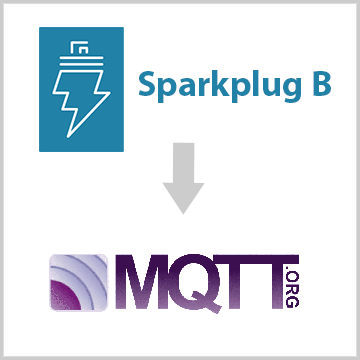
Open Automation Software can be set up to support communications to Sparkplug B Edge of Network Node data with the built-in Host Application interface. OAS is an EoN Node and Host Application interface for Sparkplug B. OAS is also an MQTT Client and an MQTT Broker, allowing you to access your Sparkplug B data via MQTT. This tutorial walks you through downloading and installing OAS, configuring a Sparkplug B driver, configuring tags, and reading and writing to them via MQTT.
Step 1. Download and Install the Open Automation Software and Start the OAS Service
If you have not already done so, you will need to download and install the OAS platform. Fully functional trial versions of the software are available for Windows, Windows IoT Core, Linux, Raspberry Pi and Docker on our downloads page.
On Windows run the downloaded Setup.exe file to install one or more of the Open Automation Software features. Select the default Typical installation if you are not sure what features to use or the Custom installation if you want to save disk space on the target system. When prompted agree to the End User License Agreement to continue the installation.
For more detailed instructions and video tutorials, visit the installation guide for your system:
Windows Installation | Linux Installation | Raspberry Pi Installation | Dockers Installation
The OAS Service Control application will appear when the installation finishes on Windows. Use this application to start the 3 Services. Run the Configure OAS application on Windows and select Configure-Tags; if the first time running, the AdminCreate utility will run to create an Administrator login as shown in Step 1 of Getting Started – Security.
Step 2. Set Up Sparkplug B Host App to Access EoN Node Data.
Select Configure-Drivers.

Enter a meaningful Driver Interface Name that you will refer to this connection and define the properties.

Set the driver to Sparkplug B.
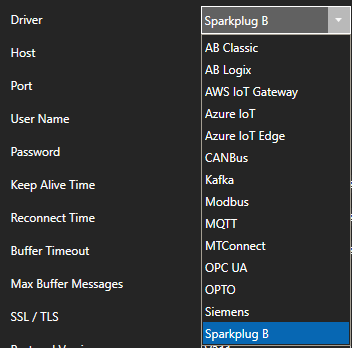
Enter the Host property to the IP Address of the of the host broker or just use localhost for a local broker.

Set the Port property of the host broker to connect to. The default port is 1883 or 8883 for SSL.

Note: The OAS MQTT Broker can be used to host data locally. To use another broker on the default ports on the same computer change the OAS MQTT Broker Port under Configure-Options-MQTT Broker.

Enter the User Name and Password if required.
Set the MQTT Protocol Version to V311 or V500.
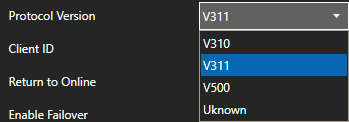
Set the Client ID to a unique value, each driver interface must have a specific value different than all other clients connecting to the host.

Set the Mode to Host App for OAS to control the online state of each Edge of Node defined to the shared Host Application ID. Or set to Client App to access EoN Node data without controlling their state.

Set the Host ID to the specific value that the Edge of Nodes will be using as the Host Application ID.

Set the Sparkplug B Version to 2.2 or 3.0.

To automatically add tags for each Metric from the matching Group, Edge of Nodes, and Devices enable the property Add Client Tags Automatically.

When enabled optionally set the Filter Groups, Edge Nodes, and Devices that tags should be added from for each of their Metrics. Leave the Filter fields blank to include all Edge of Nodes publishing data to the broker.
Select the Add Driver button in the left part of the form to add the Driver Interface as an available selection when defining Tags in the next step.

You are now ready to add tags for specific Sparkplug B EoN Node Metric values.
Note: If the Driver Interface property Add Client Tags Automatically was enabled tags will be created for you, you can skip this step to add tags manually.
Select Configure-Tags.

Note: You can add organizational Groups as many levels deep as you prefer and add tags to groups. To do this first add a Group to Tags Group at the root level, then right click on the Group in the right window to add additional Groups or Tags.
Select Add Tag.

Change the Data Source Tag property to Sparkplug B.
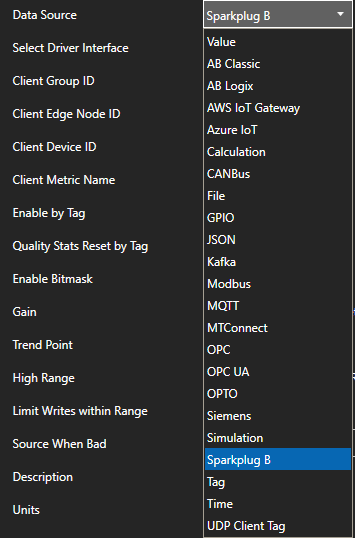
Select the correct Driver Interface from the Driver Interface pull down list.

Specify the Client Group ID, Client Edge Node ID, Client Device ID, and Client Metric Name for the Edge of Node Metric value to read and write.
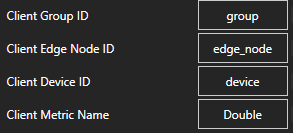
Select the Data Type of the Tag to match the data type of the Metric.
Select Apply Changes and the current value for the Metric should appear with Good Quality.
Select the Save button from the toolbar to save your configuration.

You can view the Getting Started with Sparkplug B Video to familiarize yourself with the above steps to setup OAS as a Sparkplug B Edge of Network Node and a Host Application
- 00:00 – Introduction
- 01:10 – Download OAS
- 01:46 – Quick Start
- 02:08 – Edge of Network Node
- 05:52 – EoN Tags
- 07:04 – Host Application
- 09:20 – SpB Client Tags
- 10:22 – Programatic Interface
- 10:59 – CSV Export / Import
- 12:27 – Multiple Metric Tags
- 13:46 – Modbus
- 16:10 – DCMD Metric Write
- 17:00 – Data Route
- 17:58 – Networking
- 18:17 – Save Configuration
- 18:56 – OAS Platform
Step 3. Access Your Data with the OAS MQTT Broker
The OAS MQTT broker will work without configuration but if you want to use SSL or have security set on your OAS Service you will need to configure it. Please see our Getting Started – MQTT Broker page in the knowledge base if this applies to you.
Accessing Your Tag Data (Subscribing)
This example uses MQTT Explorer, it is a free MQTT client and you can download it here.
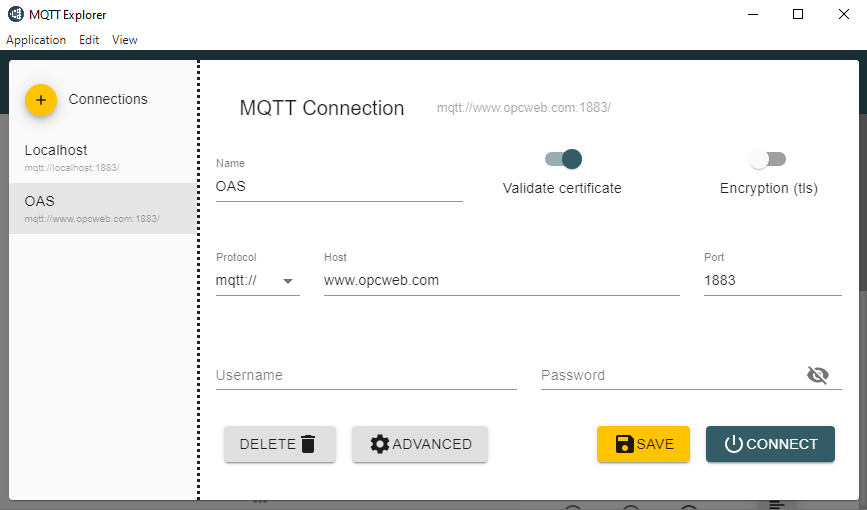
Enter the address of your MQTT Broker in the host name. This will be the IP address or domain name of where you have the OAS Server installed. If it is on your local machine, you can just enter localhost. The name field is just a friendly-name so enter something meaningful to you, perhaps your Broker ID. Enter the Port and Username and Password if you have set one up. Click on the Advanced button.

Here is where you can subscribe to your topics (OAS tags). In the Topic box, enter TagName.Value, for example, Ramp.Value and click Add. You can also subscribe to any other property of the tag, for example, Ramp.DataSource. Once you are done adding topics, click Back.

Now click on save and then connect. You should now see your data coming in. The payload is in standard JSON format and includes the Value, Timestamp, and Quality.
Writing to Your Data Source (Publishing)
Follow the same setup for the MQTT Explorer client that you did for subscribing to connect to the OAS MQTT Broker but you can skip the Advanced button part. Click Connect.
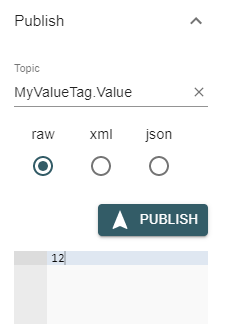
In the lower right portion of the client window, enter in your Topic, this will be the tag you are trying to write to, for example, MyValueTag.Value. Switch the selector to raw and enter a value in the text box below the Publish button. Click Publish. If you would like to write your value in json format, you can. Using the JSON Calculations in OAS you can parse the JSON message for extended functionality.
The video below, goes into detail about how to do that as well as an overview of the OAS Broker.


